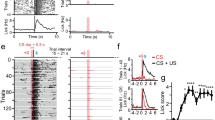Abstract
An explanatory model is developed to show how synaptic learning mechanisms modeled through spike-timing dependent plasticity (STDP) can result in long-term adaptations consistent with reinforcement learning models. In particular, the reinforcement learning model known as temporal difference (TD) learning has been used to model neuronal behavior in the orbitofrontal cortex (OFC) and ventral tegmental area (VTA) of macaque monkey during reinforcement learning. While some research has observed, empirically, a connection between STDP and TD, there has not been an explanatory model directly connecting TD to STDP. Through analysis of the learning dynamics that results from a general form of a STDP learning rule, the connection between STDP and TD is explained. We further demonstrate that a STDP learning rule drives the spike probability of a reward predicting neuronal population to a stable equilibrium. The equilibrium solution has an increasing slope where the steepness of the slope predicts the probability of the reward, similar to the results from electrophysiological recordings suggesting a different slope that predicts the value of the anticipated reward of Montague and Berns [Neuron 36(2):265–284, 2002]. This connection begins to shed light into more recent data gathered from VTA and OFC which are not well modeled by TD. We suggest that STDP provides the underlying mechanism for explaining reinforcement learning and other higher level perceptual and cognitive function.
Similar content being viewed by others
References
Bi Q, Mu-Ming P (1998) Precise spike timing determines the direction and extent of synaptic modifications in cultured hippocampal neurons. J Neurosci 18:10,464–10,472
Daw ND, Dayan P (2004) Neuroscience. Matchmaking. Science 304(5678): 1753–1754
Feldman DE (2000) Timing-based LTP and LTD at vertical inputs to layer II/III—pyramids in rat cortex. Neuron 27: 45–56
Froemke RC, Dan Y (2002) Spike-timing-dependent synaptic modification induced by natural spike trains. Nature 416(6879): 433–438
Houk J, Davis J, Beiser D (1995) Models of information processing in the basal ganglia. MIT Press, Cambridge
Izhikevich EM (2007) Solving the distal reward problem through linkage of stdp and dopamine signaling. Cereb Cortex 17(10): 2443–2452
Klopf A (1988) A neuronal model for classical conditioning. Psychobiology 16: 85–125
Kosko B (l986) Differential Hebbian learning. In: Denker JS (ed) AIP Conference Proceedings 151: Neural Networks for Computing. American Institute of Physics, New York, pp 277–288
Markram H, Lübke J, Frotscher M, Sakmann B (1997) Regulation of synaptic efficacy by coincidence of postsynaptic APs and EPSPs. Science 275: 213–215
Montague P, Berns G (2002) Neural economics and the biological substrates of valuation. Neuron 36(2): 265–284
Montague PR, Dayan P, Sejnowski TJ (1996) A framework for mesencephalic dopamine systems based on predictive Hebbian learning. J Neurosci 16(5): 1936–1947
Morris G, Nevet A, Arkadir D, Vaadia E, Bergman H (2006) Midbrain dopamine neurons encode decisions for future action. Nat Neurosci 9: 1057–1063
Niv Y, Duff MO, Dayan P (2005) Dopamine, uncertainty and TD learning. Behav Brain Funct 1: 6
Otani S, Daniel H, Roisin MP, Crepel F (2003) Dopaminergic modulation of long-term synaptic plasticity in rat prefrontal neurons. Cereb Cortex 13(11): 1251–1256
Pawlak V, Kerr J (2008) Dopamine receptor activation is required for corticostriatal spike-timing-dependent plasticity. J Neurosci 28(10): 2435
Rao RPN, Sejnowski TJ (2000) Predictive sequence learning in recurrent neocortical circuits. In: Solla SA, Leen TK, Muller KR(eds) Advances in neural information processing systems, vol 12. MIT Press, Cambridge, pp 164–170
Roberts PD (1999) Computational consequences of temporally asymmetric learning rules: I. Differential Hebbian learning. J Compu Neurosci 7: 235–246
Roberts PD (2004) Recurrent biological neural networks: the weak and noisy limit. Phys Rev E 69: 031910
Roberts PD, Bell CC (2000) Computational consequences of temporally asymmetric learning rules: II. Sensory image cancellation. J Compu Neurosci 9: 67–83
Schultz W, Dayan P, Montague PR (1997) A neural substrate of prediction and reward. Science 275: 1593–1598
Song S, Miller KD, Abbott LF (1993) Competitive hebbian learning through spike-timing-dependent synaptic plasticity. Nature Neurosci 3: 919–926
Suri R, Schultz W (2001) Temporal difference model reproduces anticipatory neural activity. Neural Comput 13: 841–862
Sutton RS, Barto AG (1998) Reinforcement learning: an introduction. MIT Press, Cambridge
Tremblay L, Schultz W (1999) Relative reward preference in primate orbitofrontal cortex. Nature 398(6729): 661–663
Waelti P, Dickinson A, Schultz W (2001) Dopamine responses comply with basic assumptions of formal learning theory. Nature 412: 43–48
Wörgötter F, Porr B (2005) Temporal sequence learning, prediction, and control: a review of different models and their relation to biological mechanisms. Neural Comput 17(2): 245–319
Author information
Authors and Affiliations
Corresponding author
Additional information
This material is based upon work supported by the National Science Foundation under Grants No. IOB-0445648 (PDR) and DMS-0408334 (GL) and by a Career Support grant from Portland State University (GL).
Rights and permissions
About this article
Cite this article
Roberts, P.D., Santiago, R.A. & Lafferriere, G. An implementation of reinforcement learning based on spike timing dependent plasticity. Biol Cybern 99, 517–523 (2008). https://doi.org/10.1007/s00422-008-0265-6
Received:
Accepted:
Published:
Issue Date:
DOI: https://doi.org/10.1007/s00422-008-0265-6




